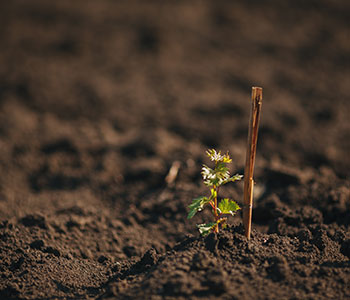
Aspects of vine breeding in times of climate change
Planting vines is a far-reaching decision – and not one that winegrowers make overnight. A vineyard must last for the next two generations, and the financial outlay is considerable. It also takes years before the first harvest. In an era of climate change, the choice of grape variety and land becomes an increasingly complex challenge.
April 2025
Source:
Klimawandel & Weinbau. Podcast Wolfgang Staudt with Gast Prof. Hans Schultz, Geisenheim. wolfgangstaudt.com
Will Grüner Veltliner still work in the future? Will it soon be too hot for Riesling with its fine acidity structure? How will the elegant Blaufränkisch cope with increasing drought stress and how will we handle the increasing fungal pressure? Are fungus-resistant varieties (PiWis) a solution? Are we allowed to think about CRISPR/Cas? Which sites will be suitable in the future? And do we have enough time to effectively tackle the consequences of climate change with new methods?
It is questions like these that are currently preoccupying many winegrowers - and probably also depriving them of sleep. There are no quick solutions. But there are promising ideas, research and approaches. The President of Hochschule Geisenheim University, Professor Hans Schultz, talks about this - in German language - with podcast host Dr Wolfgang Staudt. The title of this episode: »Wurzeln schlagen in der Zukunft - Klimawandel, Weinbau und Verantwortung« (Rooting in the future - climate change, viticulture and responsibility).
Hans Schultz is not only one of the leading international climate experts in viticulture, he is also an unwavering admonisher with vision. In his interview with Wolfgang Staudt, he clearly identifies the challenges of climate change: rising temperatures, more frequent extreme weather events, eroding soils - and the illusion that water will fix it.
While heavy hail is falling outside, I am summarising the podcast for you - without any claim to completeness. These lines in no way replace the conversation - on the contrary: they are intended to encourage you to listen.
Schultz's most important remarks:
- Climate dynamics and the risk of frost. Ever since the late frost in 2017, which caused billions of euros worth of damage across Europe, it has been clear that what we are experiencing is not a freak weather phenomenon, but structural climate stress.
Schultz refers to the dynamics of global air currents: The jet stream is becoming more unstable due to Arctic warming, which can lead to outbreaks of cold air as far as Central Europe or North Africa.
- To counter this, Hochschule Geisenheim University has been developing a global frost map for risk assessment and location advice since 2021. The aim is to collect worldwide data on late frost events and climatic conditions and process it in a digital map. This frost risk map is intended to help winegrowers better assess the risk of late frosts at existing and potential winegrowing locations and develop suitable adaptation strategies. - Soil, humus and CO2 sinks
- Soils lose their water storage capacity - and their function as a living reservoir - through erosion, compaction and overuse.
- The role of HUMUS is often underestimated. Schultz points to the central importance of building up humus as a long-term strategy for improving soil structure, fostering soil life and sequestering carbon. Humus-rich soils can not only store significantly more water, but are also more resistant to erosion and extreme weather events. In the context of the international 4 per 1000 initiative, he emphasises that the build-up of organic carbon in the soil - by 0.4% per year - offers enormous potential for binding CO2. However, this is by no means a solution that can be realised in the short term: building up functioning, stable humus structures requires time, suitable management methods and a systemic perspective.
- The 4 per 1000 initiative, presented at the 2015 World Climate Conference in Paris, aims to increase the organic carbon content in soils by 0.4% per year - a measure that, in purely mathematical terms, could significantly slow down the annual global rise in CO2. Schultz refers to this potential, but emphasises that such an increase can only be achieved through far-reaching changes to the agricultural system.
- Schultz sees a particularly impressive example of the negative effects of misguided land use in radical deforestation - for example in the south of France. They not only lead to the loss of valuable vegetation, but also to massive CO2 emissions due to the destruction of organic matter in the soil. Schultz estimates the ecological and economic consequences of such interventions at up to 100 to 200 million euros. This illustrates the potential that is lost if soil health is not considered in long-term strategies. - Greening, biodiversity and breeding
- Schultz calls for targeted breeding programmes for greening plants, adapted to drought, erosion and microclimate.
- Greening, water management and soil intelligence are key research topics for the future. - Choice of variety and resilience
- Piwis and varieties such as Alvarinho show potential for climate adaptation. Schultz explicitly mentions Alvarinho as an example of a heat-tolerant variety that can deliver stable quality under hot and dry conditions. Originally from the north-west of the Iberian Peninsula, Alvarinho has a compact grape structure, thick berry skin and a fine acidity profile.
- Characteristics that make them interesting for cultivation in warmer locations. However, Schultz emphasises that even such varieties cannot be used universally. Site selection, soil conditions and cultivation systems must be carefully considered.
- chultz emphasises that the choice of variety should not be based solely on oenological criteria, but should be considered strategically in terms of location, water requirements and stress resistance. - Irrigation as a luxury
- Schultz describes water as a luxury good whose availability is neither self-evident nor inexhaustible.
- He urgently warns not to view irrigation as a universal solution to climate change-related stress situations.
- Rather, precise, data-based water management is the key: irrigation should only take place if it can be specifically justified by monitoring systems - such as sensors for soil moisture, transpiration and leaf water status.
- He is particularly critical of blanket irrigation systems in regions where groundwater reserves are already dwindling.
- Schultz advocates adapted forms of cultivation that rely on the highest possible water storage capacity of the soil - for example through humus build-up, suitable green cover and deep-rooted vine rootstocks. - Long-term research and management systems
- chultz refers to the results of the so-called DOK study in Switzerland since 1978 and to long-term studies at Geisenheim University, in which conventional, organic and biodynamic cultivation methods are compared in terms of yield, soil quality, nutrient efficiency, biodiversity and climate impact.
- In these studies, organically and biodynamically farmed areas tend to show greater ecological stability in stress situations (e.g. drought, pest pressure) than conventionally farmed areas.
- The differences relate in particular to soil life, water storage and microbial diversity.
- Schultz emphasises that reliable statements can only be made on the basis of long-term research - often only after 20 years.
- He describes the importance of the microbiome - especially mycorrhiza and soil organisms - as a scientific black box with great potential for the future. - Systemic sustainability
- Schultz calls for a whole institution approach: sustainability must permeate all areas and processes - from education, research and production to packaging and logistics. You can also see my approach as a Master of Sustainability in practice and consulting.
- Even supposedly irrefutable standards such as the glass bottle need to be critically scrutinised. - International perspective
- In the dialogue, Schultz refers to several international initiatives that are dedicated to exchanging ideas and actively addressing the challenges of climate change in viticulture - including the Porto Protocol, Sustainable Winegrowing Australia and Wine in Moderation. He also emphasised the need for more involvement from scientific institutions in these networks. In the Porto Protocol, Hochschule Geisenheim University is currently the only scientific institution that is actively involved - a fact that Schultz criticises.
Since 2019, incidentally, I have been the Austrian representative for the Porto Protocol, an international initiative for climate responsibility in viticulture, in which knowledge, solutions and best practices are networked. - Thinking future- Schultz talks about land stewardship: what happens to vineyards when viticulture is no longer viable?
- Alternative products made from grapes - alcohol-free, cosmetic, functional - are becoming increasingly important.
- Schultz says: 'Viticulture can become a pioneer in dealing with climate change - if we act now.'
They are all logical considerations - some new, some familiar. But they all deserve to be included in your own strategy. Listen to the podcast at your leisure: You will discover one or two new details.




